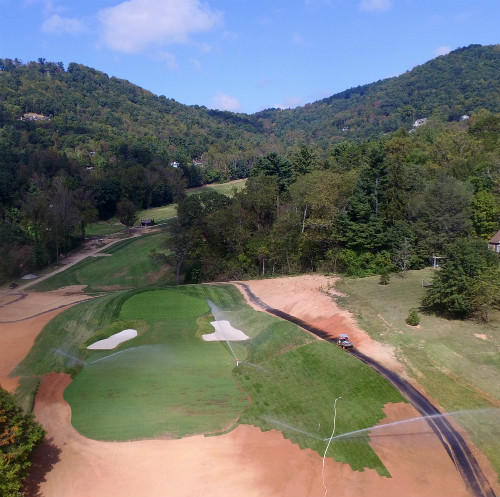
The Course's Modern Transformation to the Original Vision of Donald Ross
For all of 2016, Country Club of Asheville's Donald Ross golf course was closed due to extensive restoration by course architect Richard Mandell. He made many great improvements, such as new 007 Bentgrass on all 18 greens, a restored creek crossing on No. 10, a new practice facility, and rerouted cart paths, to name a few. For Mandell, the most exciting part of the project would be discovering and returning the forgotten work Ross had created in 1928.
“Renovations at the Country Club of Asheville have been a very enjoyable experience for me working alongside Superintendent Robby Watts and his crew,” explains Mandell. “It was fun to incorporate my knowledge of Ross in creating new greens where possible and uncovering some of the original greens buried under a few existing ones.”
Using information from long-time country club members and notes from the original construction, Mandell tried to mimic the original course layout as closely as possible. Every piece of data gathered would allow him to focus on his goal of preserving the original instead of making design changes. “My early process walk-through with Les Stradley, who was the golf pro there in the 1970s, was an eye-opener as to the changes to the greens in the ‘60s from Ross’ work,” says Mandell.
By changes he means “changes.” For example, many believed the No. 12 green was the original putting surface elevation. However, it was discovered that the green Donald Ross built was under seven feet of dirt, one of the many surprises found throughout the construction. The green would be restored to the original grass line.
“I am most proud of the finish work to the features and shaping of the putting surfaces, which was done by NMP Golf Construction and my shaper, Marc Burger,” says Mandell. “I hope the greens are as fun to putt on as they were to design. Mr. McConnell wanted a set of very interesting, challenging putting surfaces, which is what we delivered. I believe they are the soul of the course now.”
Besides the changes to the greens, another adaptation required moving the first tee. The results: A better view of the fairway for the golfer’s drive and the creation of space for a 10,000-square-foot practice putting green next to the clubhouse. Relocating the tee may not have been what Ross envisioned, but it’s a great enhancement everyone will enjoy.
The reconstruction efforts provide promising course conditions, especially with the new drainage and turf. Strategically chosen for Asheville’s unique climate, the 007 Bentgrass greens will perform very well in the cool weather along with the rest of the course. The fairways are also Bentgrass, while the roughs are a blend called Midnight Kentucky Bluegrass. To reduce excessive mowing, Mandell used Meyer Zoysia on the sand bunker faces, just as he did at Raleigh Country Club in 2006. Although Zoysia is a slow-growth, warm-season grass used all over the Southeast, it is new to the Asheville area.
“Overall, the work here at CCA is some of my best,” says Mandell. “I think the green complexes and the bunkering are a testament to Ross’ practical approach to design, yet we seized the opportunity to create a bit more variety from hole to hole. It was an honor to work on the 16th hole, as it has always been one of my favorites as depicted in one of my favorite books on golf architecture, George Thomas’s Golf Architecture in America.”